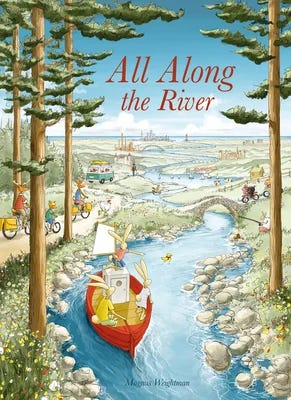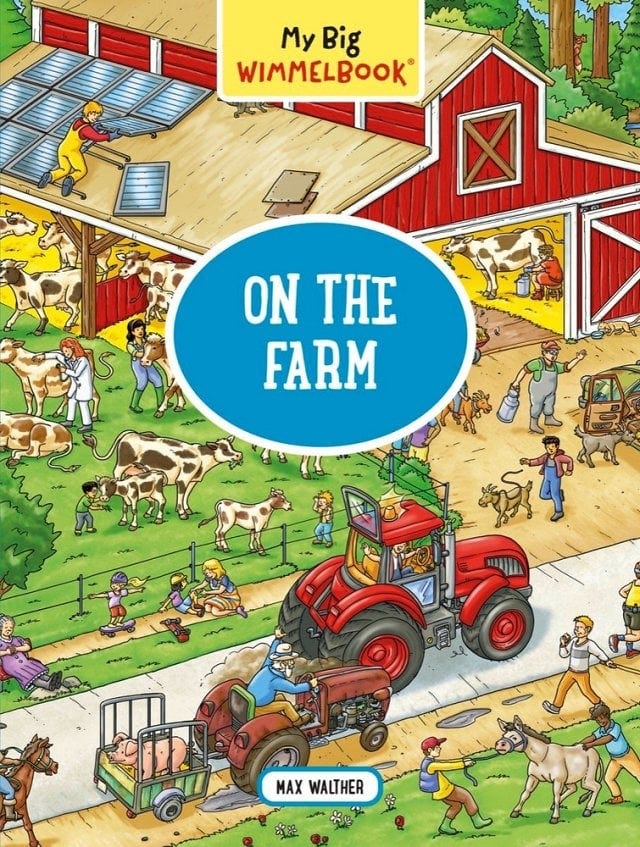If I were to describe a wimmelbook (wimmelbilderbuch, if you want to be technical) to you, you’d probably recall time spent absorbing the intricately detailed, chaotic scenes from Where’s Waldo (or Wally if you’re from a Commonwealth country) madly searching for the bespectacled, red-and-white striped black-haired hero. The iconic character is certainly an example of a wimmelbook but I fear it misses the mark.
Wimmelbooks is a genre of book popularized by German children’s illustrators. They are panoramic views of scenes that are overflowing with life. The scene presents itself to the child and it’s up to the child to figure out how they want to navigate the scene and what type of narrative they want to follow. These are books that grow with children; at the ripe age of 2, they may call out familiar objects (“cow!”) but as they grow, they’ll start noticing the connections between the objects and characters are start understanding the story being woven throughout the scenes. As they get even older, they’ll understand the tongue-in-cheek humor and the little easter eggs peppered throughout.
The joy and soothing pleasure of a wimmelbook is in its immersion. (And I do NOT want to be immersed in Waldo/Wally’s wacky world). The pages of these books offer a zoomed-out view of typical scenes we encounter in real life—going grocery shopping, walking through the town square, navigating the airport, etc. But it’s done from the safety and comfort of a book.
As you flip through the wordless pages, you’ll see the same characters move through different scenes engaged in their own, busy life. As you follow along, you’ll be able to piece together a given character’s day. Like a neighbor, they become familiar to you as you observe their routines and relationships. That familiarity breeds fondness and it’s incredibly hard not to fall in love with these quaint miniature worlds.
I adore wimmelbooks for the same reason so many of us Millennials fell in love with The Sims—it’s an opportunity to experience real life from the safety of our homes and imaginations. Here are the top reasons these are some of my absolute favorite sub-genres of children’s books:
Gripping—seriously, it is really, really hard not to be completely absorbed by these books as you observe all the lovely, thoughtful details
Choose-your-own-adventure—Most wimmelbooks have a myriad of characters featured and the best part is that you can follow each of these characters’ individual storylines. This means that every “reading” of the book can be different from the previous “reading”!
Educational—There’s so much quiet learning that happens from these books. Kids will take in all the ways characters interact with each other and their surroundings. It’s a field trip in a book. And it allows for meaningful conversation, too. We can explain the process of doing something or answer kids’ questions about a particular setting.
Age-agnostic—these books are great for kids of all ages. Probably packs the most (non-didactic) educational punch for younger kids, there’s enough fascinating detail and funny little easter eggs to keep older kids (and adults) entertained too!
Wordless—Sometimes I get tired of reading so it’s a lot of fun to not have to read-read and still read a picture book
These books, while large, are great to tote around with you to places where there may be waiting involved (restaurants, doctor’s offices, planes, etc.). It’s a great way to keep kids (and even yourself) occupied. I also think it’s a great way to sharpen attention-to-detail and memory retention (keeping track of the different happenings in each scene) skills.
I’m very passionate about wimmelbooks so I also want to clarify what they are NOT. Wimmelbooks are about zooming out and watching a wide swath of people engaging in some type of activity or setting. While they certainly have elements of seek-and-find books (like I Spy) they are not the same. Also, good wimmelbooks tend to be wordless or very word-light. The story is told in the illustrations and invites the reader to engage with the different characters and come to their own conclusions as they piece the characters’ stories together page by page, scene by scene. Richard Scarry’s Busytown books often get bucketed into this category; however, I would not consider them to be a true wimmelbook. They are pedantic where a true wimmelbook lets the reader learn from seeing and observing. The most words you’ll see in a wimmelbook are at the very beginning when the author-illustrator introduces the characters we’ll be seeing in the pages that follow.
All Around Bustletown: Spring
Illustrated by Rotraut Susanne Berner
Recommended Ages: 2+ years
Honestly, I spent way too much time “reading” this wordless book. I pored through all the little details, completely captivated by the different scenes and characters. Berner, a famous German children’s book author, is renowned for her wimmelbooks. The Bustletown series are large board books that are teeming (practically spilling off the page) with life. Berner crams lots of details in without overwhelming us. In her seasonal wimmelbook series (all of which are excellent), we see the thawing away of winter and green lushness begin to emerge in the scenes around town. There are so many hidden gems to discover and kids of all ages will be engrossed trying to find all the little stories and characters. Berner’s artwork is delightful in an old-fashioned way—beautiful, diverse quirky characters brought to life with soft colors and nuance.
Buy now* | Find it at your library
All Along the River
Written and Illustrated by Magnus Weightman
Recommended Ages: 2+ years old
In this outdoorsy, river adventure, we traipse down a river encountering a hodgepodge of scenes from industrial to castle vistas to beachy vibes. When Bunny Rabbit loses her beloved rubber duck toy in the river, she and her brothers hop on their little boat and head down the river to track down the toy. The muted watercolor illustrations are quietly lovely, replete with intricate nuance that will make you lean in to observe all the little details. This wimmelbook is unlike the others in that there’s a clear set-up to the “story” (the quest to retrieve the lost toy ducky) and each spread has a brief prompt to help keep readers on track. I’ll be honest, I mostly skipped over these little blurbs as I felt they were unnecessary. However, one surprising detail at the end that I loved is the very last illustration breaks the fourth wall (in a manner of speaking) and the characters observe, as we do as readers, every scene in the book.
Buy now* | Find it at your library
My Big Wimmelbook: On The Farm
Written and Illustrated by Max Walther
Recommended Ages: 3+ years old
This particular wimmelbook takes us to the farm and each spread showcases various parts of a farm. With the first spread, we see the various buildings that comprise the farm. We see farm animals and heavy machinery. A perfect, detailed introduction on what to expect should you ever visit a farm. We see all the goings-on and there are a lot of wonderful little clues to the role various characters play. The illustrations are bright and colorful (think barn red!) and there are so many little details you could easily spend an hour poring through the pages. One detail I really enjoyed was the movement through time. With the very first spread, it’s clear we’re starting the day bright and early but you can see the shadow the sun casts as you continue through the book. By the last spread, it’s dark and the day at the farm is coming to a close.
Buy now* | Find it at your library
Let’s Talk…
If you’re a fan of wimmelbooks, which is your favorite?
How do you see yourself incorporating wimmelbooks into your kids’ reading?
*Thank you for using (at no additional cost to you) the affiliate links in this post! :-)









These books were new to me. What fun.
I had never heard the term Wimmelbook. Now I want to create one!